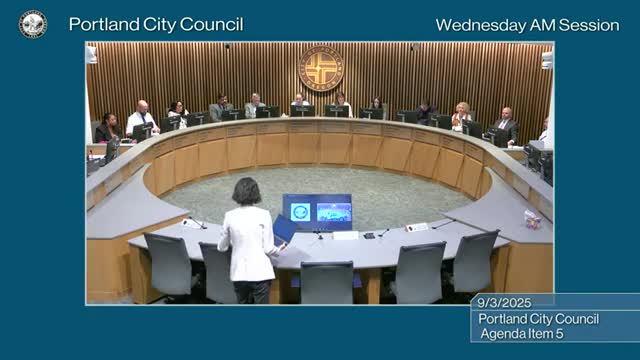Portland Council Approves Homelessness Ordinance Modifying Development Code Requirements
September 03, 2025 | Portland, Multnomah County, Oregon
This article was created by AI summarizing key points discussed. AI makes mistakes, so for full details and context, please refer to the video of the full meeting. Please report any errors so we can fix them. Report an error »

In a recent Portland City Council meeting, the focus was on an ordinance aimed at addressing housing and development challenges in the city. Claire Adamsick, a policy analyst and staff member of the Homelessness and Housing Committee, presented the ordinance, known as Document 2025-314, which had previously been discussed in the committee on August 12.
The ordinance proposes significant amendments to four chapters of the Portland city code, specifically targeting development projects that meet certain financial thresholds. Key changes include suspending street tree planting requirements for building additions and alterations until January 1, 2029, and reducing minimum tree planting size requirements in specific situations. Additionally, the ordinance seeks to suspend non-conforming upgrade requirements for all projects until the same date, which could ease the burden on developers.
Another notable aspect of the ordinance is the suspension of seismic evaluation report requirements for projects involving buildings constructed or renovated before 1974, provided they meet a specified valuation threshold. Furthermore, it proposes a partial waiver of street frontage improvements for significant alterations that do not increase occupancy.
The ordinance is designed to streamline the permitting process, which has been a point of concern among community members. During the committee meeting, four individuals provided testimony, with three submitting written comments. The feedback emphasized the need for expedited permitting to support the revitalization of commercial spaces and highlighted the importance of addressing infrastructure costs in relation to the city's housing production goals. There was also a call to extend the two-year grace period for bringing nonconforming developments up to code.
Overall, the discussions reflect a proactive approach by the Portland City Council to tackle housing and development issues, aiming to facilitate growth while considering community input. The ordinance's passage could significantly impact the city's development landscape, particularly in terms of easing regulatory burdens and promoting timely construction projects. As the council moves forward, the implications of these changes will be closely monitored by both developers and community advocates.
The ordinance proposes significant amendments to four chapters of the Portland city code, specifically targeting development projects that meet certain financial thresholds. Key changes include suspending street tree planting requirements for building additions and alterations until January 1, 2029, and reducing minimum tree planting size requirements in specific situations. Additionally, the ordinance seeks to suspend non-conforming upgrade requirements for all projects until the same date, which could ease the burden on developers.
Another notable aspect of the ordinance is the suspension of seismic evaluation report requirements for projects involving buildings constructed or renovated before 1974, provided they meet a specified valuation threshold. Furthermore, it proposes a partial waiver of street frontage improvements for significant alterations that do not increase occupancy.
The ordinance is designed to streamline the permitting process, which has been a point of concern among community members. During the committee meeting, four individuals provided testimony, with three submitting written comments. The feedback emphasized the need for expedited permitting to support the revitalization of commercial spaces and highlighted the importance of addressing infrastructure costs in relation to the city's housing production goals. There was also a call to extend the two-year grace period for bringing nonconforming developments up to code.
Overall, the discussions reflect a proactive approach by the Portland City Council to tackle housing and development issues, aiming to facilitate growth while considering community input. The ordinance's passage could significantly impact the city's development landscape, particularly in terms of easing regulatory burdens and promoting timely construction projects. As the council moves forward, the implications of these changes will be closely monitored by both developers and community advocates.
View full meeting
This article is based on a recent meeting—watch the full video and explore the complete transcript for deeper insights into the discussion.
View full meeting
